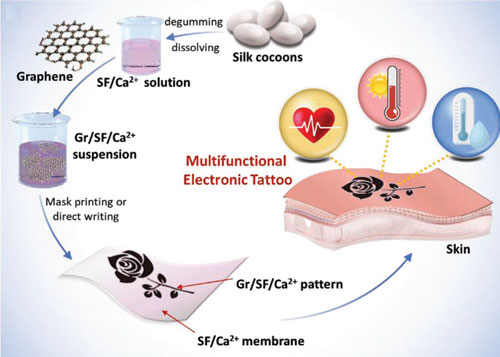|
NOVIDADES
Electronic tattoos (e-tattoos) – or epidermal electronics – are an extremely thin form of wearable electronics. They are lightweight and soft, which allows them to be intimately mounted on human skin for noninvasive, high-fidelity sensing. In previous Nanowerk Spotlights we have already reported on various applications for these e-tattoos, be it as stick-on dosimeters to measure UV exposure, graphene-based skin biosensors, or lab-on-skin for wearable health monitoring. During the operation of e-tattoos, they are constantly exposed to external mechanical inputs such as bending, twisting, pressing, and cutting, which may cause mechanical damage and lead to malfunction. In new work reported in Advanced Functional Materials ("Self-Healable Multifunctional Electronic Tattoos Based on Silk and Graphene"), researchers in China have demonstrated a self-healing silk e-tattoo that shows high sensitivity to multiple stimuli, including strain, humidity, and temperature based on a unique graphene, silk fibroin, Ca2+ (Gr/SF/Ca2+) combination.  Schematic illustration showing the fabrication process of the Gr/SF/Ca2+ e-tattoo and its stable adhesion on human skin. Reprinted with permission by Wiley-VCH Verlag
The graphene flakes distributed in the matrix form an electrically conductive path that is responsive to environmental changes, such as strain, humidity, and temperature variations, endowing the e-tattoo with high sensitivity to multi-stimuli. Remarkably, the e-tattoo can be healed with an efficiency of 100% even after being fully fractured within 0.3 seconds simply by wetting it with a droplet of water because of the reformation of hydrogen and coordination bonds at the fractured interface. "Based on the superior capabilities of our e-tattoos, we believe that such skin-like devices hold great promise for manufacturing cost-effective artificial skins and wearable electronics," notes Zhang.  Left: Photograph showing a four-leaf clover e-tattoo attached to the forearm. Right: Photographs of the tattoo on skin in different states: stretched (upper), compressed (middle), and twisted (lower). Reprinted with permission by Wiley-VCH Verlag
Despite the large potential of silk fibroin for use as wearable electronics and even e-tattoos, its applications in wearable electronics are largely limited to its use as a substrate, rather than its use as the active functional material. Graphene shows great promise for e-tattoo applications because it is mechanically robust, electrochemically stable, and biocompatible. Moreover, graphene materials can be functionalized through various physical and chemical approaches, thereby providing plenty of room for tailoring the properties and performance of graphene-based sensors. "The integration of graphene materials and silk has been explored previously, but the majority of studies focuses on mechanical enhanced materials," notes Zhang. "We found that silk/graphene composite materials are highly promising for emerging epidermal electronics." Her team explored the performance of their e-tattoo as strain, humidity, and temperature sensor and found that it can monitor a variety of daily life sensations, including electrocardiogram (ECG), breathing, and temperature, with high sensitivity, fast response, and long-term stability. Rather than having to rely on various instruments to monitor different parameters of human health, this opens the possibility of an effective, inexpensive and simple method for multi-functional monitoring over extended periods of time. "Our research group focuses on the scientific, physical and chemical properties of the preparation of nano-carbon and silk materials, and focuses on the development of new materials for flexible wearable systems," Zhang concludes. "At present, we mainly focus on carbon nanotubes, graphene and natural silk protein materials, explore their preparation methods, structure-performance correlation, and develop their applications in the fields of wearable electronics." "In my point, there are still many challenges to be overcome towards ideal wearable sensors and energy equipment," she adds. "The ultimate direction in this field is the integration of various wearable electronics into smart systems, which will contribute to the development of medical applications, heath care and artificial intelligence." By Michael Berger. Accessed: Mar 15, 2019. |
|||||||||||||||||||||||||